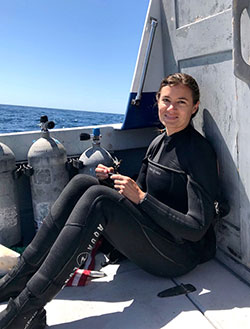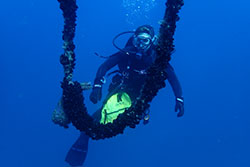Coates working on sea cucumber monitoring surveys in 2018 at Anacapa Island, about 11 miles of the coast of Port Hueneme in Ventura County.

Coates’ job involves using statistical analysis to help scientists predict how policy decisions will affect the health of a fishery.

Dive work for CDFW’s Invertebrate Fisheries Management Project.
Staff in CDFW’s Marine Region work to sustainably manage California’s marine resources. Julia Coates, a Marine Region senior environmental scientist, works on quantitative analysis and experimental design projects involving both invertebrate and finfish populations. Her ultimate goal is to produce analyses that can help inform future policy decisions. Much of her work involves predictive modeling—a cutting-edge form of statistical analysis that helps scientists predict how various policy decisions will affect the health of a fishery. With those predictions in hand, scientists can choose the policy decision that most closely aligns with their goals for a fishery.
Coates began her academic training with an undergraduate degree in integrative biology from UC Berkeley. She then completed coursework and gained professional fisheries experience at the University of Washington. Her next stop was San Francisco State, where she earned a master’s degree in biological oceanography. Next came a job doing environmental consulting in San Diego. She then completed a PhD in the joint program between UC Davis, and San Diego State, focusing on pink abalone in Southern California kelp forests. She followed that with a post-doctoral fellowship looking at the relative impacts of water quality and fisheries on the biodiversity of Southern California rocky reefs. In 2014, she was hired by CDFW as an environmental scientist with the Invertebrate Fisheries Management Project. She was promoted to her current position as senior environmental scientist in 2018.
How would you explain statistical modeling to a layperson?
Much of my work involves helping the Marine Region implement a relatively new type of fisheries analysis approach called Management Strategy Evaluation (MSE). MSE is a way to help compare the likely outcomes of different management approaches. It helps answer questions about which approaches are more likely to achieve different goals given uncertainty due to both environmental variability and error in our ability to monitor fisheries and implement management actions. Stock assessment is familiar to many who are involved in fisheries. While stock assessments estimate where a stock is today relative to the past, MSE looks to the future.
Think of it like the simulation testing that’s done to determine the safety of a car or how weather-proof your tent is. The product is tested in a simulation of the real world before it’s actually used in the real world. In our case, we’re simulation testing a management action, like changing a fish’s legal-size limit, before implementing it. We might also simulation test an alternative management action, like a limit on fishing effort, and compare the outcomes of those two options. Imagine we do many simulations, each performed under slightly different environmental conditions. Then our outcome is actually a range of potential future realities that we can describe statistically.
Here’s how it works: We construct a biological model of the fished population. It is basically a series of equations that calculate the number of births and deaths (including harvest) in each time step. We can enter known or closely estimated inputs into the model to produce simulated past harvest and population sizes. When we compare that simulated past to our actual data about the past, and the two are similar, we have reasonably good confidence in our model to describe likely patterns in the future. We then use the model to calculate future fish populations under a particular management approach. An example might be a catch limit that is adjusted based on a fisheries-independent abundance index like an annual survey. Our simulation includes the output of the annual survey, calculates a recommended catch limit, applies that catch limit to the simulated fishing in the next time step, and then the process continues. It’s called closed loop simulation. Where the population ends up tells us if that management approach is likely to lead to a sustainable fishery. Of course, we also track simulated catches along the way to see if it is an economically sound approach.
Before we had the computing power to do these types of simulation experiments, scientists would have to try to do this in real time. That’s basically how fisheries management was done. You do some sort of stock assessment to try to estimate how healthy the stock is. Then you would choose a management action, try it in real time, and wait 10 or 20 years to observe what happens. Then you would decide to continue what you're doing or take another approach. Now we can simulate possible outcomes as well as address questions about how those outcomes might differ under different environmental conditions and how confident we are in the results.
MSE presents a lot of great opportunities for stakeholders to get involved. Stakeholders often have information that can improve the underlying model. They can also let us know what metrics of fishery performance are most valuable to them. There are often many trade-offs when there are competing interests and stakeholders can have a seat at the table in weighing the options.
How is your new position different from your previous work as an environmental scientist?
When I started with the Invertebrate Fisheries Management Project as an environmental scientist, I wore a lot of hats and did a lot of policy and day-to-day management in addition to science. The job included interacting with the California Fish and Game Commission and interacting with stakeholders. There was limited time to focus on the science. I enjoyed being in that job for a few years because it put me in a good position to learn more about fisheries management and how policy gets created and implemented. When this opportunity came around to focus exclusively on science, I had to take it. It’s an opportunity to apply my many years of training and improve my quantitative skills.
How do you like your new role?
I love my current position, though I miss the field work in my old job. What I do now is always interesting. There’s way more work to do than I could even scratch the surface of. I’m never bored.
I did a lot of diving when I was working on the Invertebrate Management Project. I became a marine scientist because I love being in the water. I’ve been in the ocean since I was born. I grew up sailing and doing a lot of snorkeling and scuba diving with my dad. I’ve done a ton of scuba research in my career. All of my field research through my PhD was scuba related, as was much of my environmental consulting work. I am still on the Marine Region dive team and get in the water when time allows. I think it’s really important to stay connected to the tangible research we’re doing that impacts our fisheries and wider ecosystems.
It’s my goal to be as effective in my career as I possibly can be. Even though field work is essential to that, I feel I can do more by coming out of the water. I think I can do the most if I stay focused on the science and use the science to inform colleagues in the Marine Region, who can then use the data to inform the policy side.
Do you have any advice to aspiring scientists?
It’s really important to get that first environmental scientist job and to do well in it. You have to not only be comfortable in the field, but also work to be a good writer and have solid analysis skills. I see a lot of young students coming out of bachelor’s or master’s degrees and wondering where they can take their skills in the field of marine biology. Unfortunately, the opportunities can be limited. I encourage people to at least consider going back to school. It does take a long time, and it may not always be necessary. You can get an environmental science job with a range of qualifications. But the PhD level training gave me options for which direction I wanted to go in my career.
I have two kids, and I have a lot of interests outside of work, and I enjoy that balance. But it wasn’t easy to get to this point. I had my daughter halfway through my PhD coursework. My son was born two weeks after I defended my dissertation, and I jumped right into post-doctoral work and commuting long-distances with a newborn at home. Now that they’re older and I’ve been in this position for a while, I’m really happy with the way things settled out. I still get to be a scientist and I still get to be a mom, and I’m really grateful.
CDFW Photos